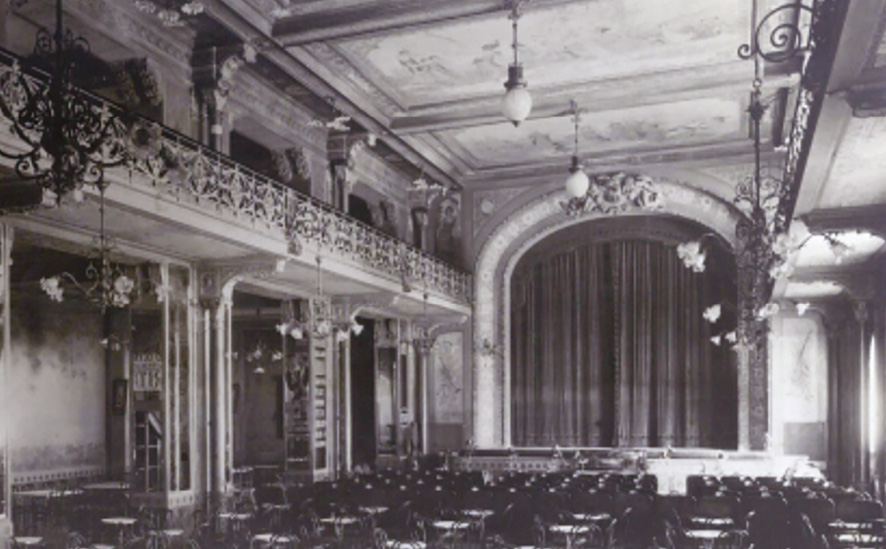Our itinerary for the discovery of Bologna’s extinct theaters leads us to Palazzo Maccaferri, at the end of via Indipendenza, where on 31 December 1898 Mayor Alberto Dallolio inaugurated the Eden Theater. Fairly small (9.5 meters wide, 20 meters long, and 7.5 meters high), it was built along with the newly-constructed Palazzo and, as its architect, engineer Attilio Murgia wrote, “it is primarily Italian Renaissance in style, with minimal projections, treated with the freedom appropriate to modern architecture and trends for floral decoration.” Decorated with cast-iron railings in perfect Liberty style, the theater was equipped with modern systems, such as lighting by the German company Ganz and heating with the city’s first radiators. It did not have the usual separation into parterre, boxes, and balconies, but facing the stage (as seen in the photo) there were six rows with nine chairs each, behind which there were small round tables with chairs. Coffee concerts were presented here, while lounges, rooms, a restaurant, beer hall, and gaming rooms were on the upper floors.
As for its performances, the Eden offered two daily coffee concerts (at 2 pm and 9 pm) with composer mentioned. Of course, it wasn’t the first place to present “variety” in Bologna, but it was the first to offer it with alternating songs and operetta, magic tricks, impressions, acrobats, dancers, a curtain raiser, Neapolitan sketches, and review in such a refined manner to an audience belonging to an upper social class.

For 25 years, the stage of the Eden presented the most famous stars of international light entertainment, such as Emilia Persico and Aurora Castillo, Tina Rossi and Pina Fleurille, Jole Bartoni, Gino Franzi, Pasquariello and Ettore Petrolini, Pepita Raquel, Pina Ciotti and Maria Campi, the woman “who invented the move,” Cléo de Merode, and Belle Otèro, thanks to whom the city entered the European theater circuit.
In the evenings, the performances of singers and impressionists alternated with all sorts of strange acts: Trohe the juggler, Munaff the magician and sketch artist, Cianchi the musical clowns, the modern gladiators The Aplenay’s, the Collins Quartet with their “dizzy can-can,” the Henry Tyler cyclists, Eli Luy’s acrobatic dances, Miss Mary the trapeze gymnast, etc., etc.
But very soon, in addition to live performances, there were movie projections: in 1899, Retrobiograph showed “animated pictures;” in April 1901 the Lumière Cinematograph was shown, and in 1903, while the main room was filled with acrobats, cyclists, singers and gymnasts, the upper lounge presented the Paris Cinematograph.
After the war, in 1921, there was quite an uproar over the evening of “Teatro Futurista della sorpresa” by the Rodolfo De Angelis Troupe, a provocative show in which thirty 3-minute plays were presented one after another, accompanied by futuristic music consisting of various kinds of noises.
But these were its last moments of glory: the Eden Theater’s story ended in 1923, when Palazzo Maccaferri became the headquarters of the Electrical Company.

.jpg)



.png)